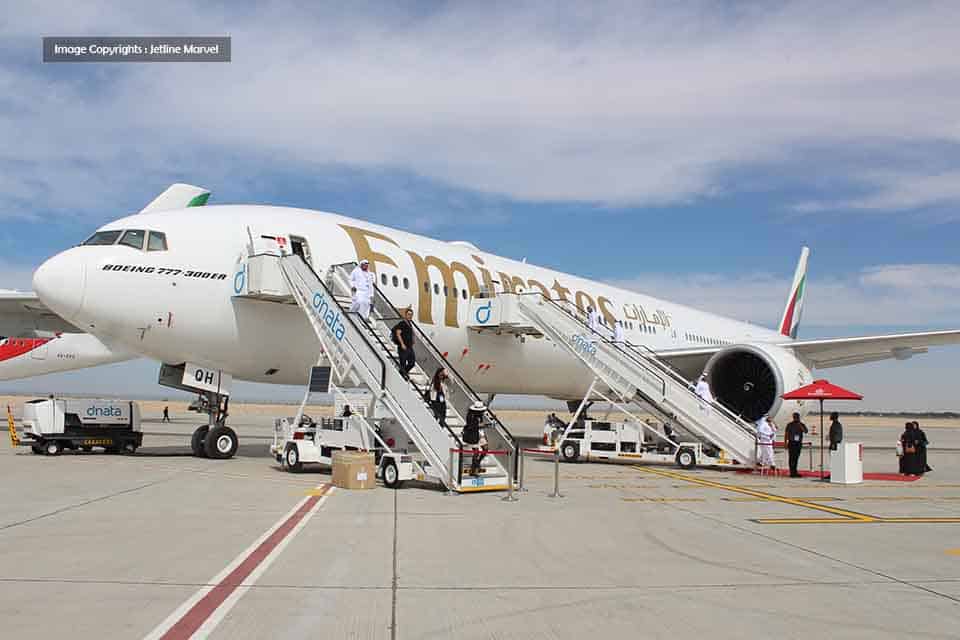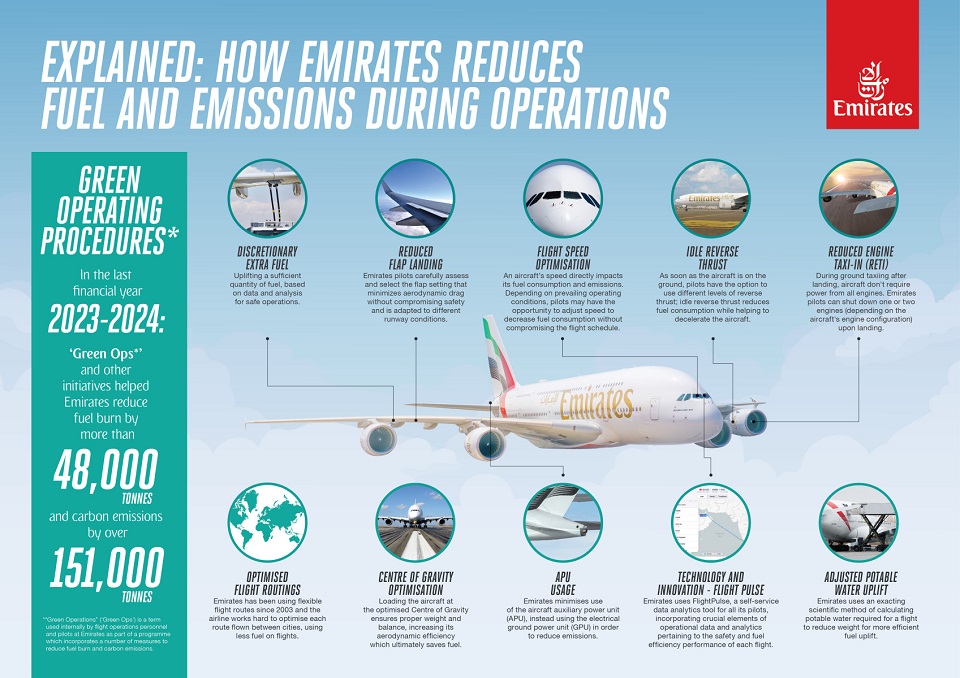Aviation
How Emirates pilots reduce fuel and emissions during operations

Flying smarter and minimizing fuel consumption and emissions starts in the cockpit. Emirates embarked on implementing “Green Operating Procedures” (‘Green Ops’) in 2016, adopting a multi-pronged approach to reduce on-ground and in-flight fuel use.
This initiative also provides pilots with necessary education, awareness, data analytics, and technology to manage flights efficiently.
Led by an internal cross-functional Operations Efficiency Steering Group, Emirates aims to mitigate unnecessary fuel burn and emissions while maintaining high safety standards.
In the financial year 2023-2024, ‘Green Ops’ and other initiatives helped reduce fuel burn by over 48,000 tonnes and carbon emissions by more than 151,000 tonnes. Key operational measures include:
Discretionary Extra Fuel
- Pilots assess operational circumstances to uplift extra fuel beyond the minimum regulatory standards only when necessary, resulting in a significant reduction of discretionary extra fuel uplift.
Flight Speed Optimization
- Pilots optimize flight speed to reduce fuel consumption while maintaining schedule integrity, as part of Emirates’ standard operating procedures.
Reduced Flap Landing
- Pilots select flap settings that minimize aerodynamic drag, reducing fuel consumption without compromising safety.
Idle Reverse Thrust
- Upon landing, pilots use idle reverse thrust to decelerate the aircraft, depending on runway conditions, to reduce fuel consumption.
Reduced Engine Taxi-In (RETI)
- After landing, pilots shut down one or two engines during ground taxiing, increasing the use of RETI sevenfold since its introduction.
Optimized Flight Routings
- Emirates uses flexible flight routes, optimizing each route for fuel efficiency and time savings since 2003.
Technology and Innovation – FlightPulse
- Emirates introduced FlightPulse, a self-service data analytics tool developed with GE Digital Aviation Services, enhancing monitoring and collaboration for improved safety and fuel efficiency.
Center of Gravity Optimization
- Aircraft are loaded to optimize the center of gravity, enhancing aerodynamic efficiency and saving fuel.
APU Usage
- On the ground, Emirates reduces APU usage in favor of electrical ground power units (GPU), reducing emissions by over 30%.
Adjusted Potable Water Uplift
- Flights upload the required amount of potable water calculated scientifically, reducing weight and ensuring fuel efficiency without compromising passenger comfort.
Through these comprehensive measures, Emirates pilots play a crucial role in reducing fuel consumption and emissions, contributing to more sustainable airline operations.

Aviation
Airbus Enhances A350 Cabin with 10-Abreast Seating

Airbus has announced a new partnership with Jiatai Aircraft Equipment, a Chinese aircraft seating manufacturer, to supply upgraded economy-class seats for the A350 widebody series.
This collaboration, unveiled at the 2024 Airshow China, focuses on developing a newly designed economy seat tailored for the A350‘s New Production Standard (NPS) cabin.
One of the key features of the NPS cabin is the ability to accommodate 17-inch wide economy seats, compared to the previous 16.5-inch wide seats that airlines were limited to in the A350’s earlier configurations.
British Airways Unveils Its Brand-New First Class Cabin for the Airbus A380
This change is made possible by the expanded space in the NPS cabin, which is 35 inches longer and 4 inches wider than the previous version. This extra space is achieved by slightly moving the cockpit wall forward and shifting the rear pressure bulkhead back by one frame.
The wider cabin allows airlines to add up to 30 extra economy seats without compromising comfort. For airlines opting for a 3-4-3 seating layout, the 17-inch wide seats are an excellent choice for a more comfortable passenger experience. However, some airlines, such as Iberia, may choose to retain a 9-abreast layout with wider seats for added comfort.
The NPS cabin also offers enhanced flexibility for airline operators. One major advantage is the ability to easily switch between a 9-abreast and 10-abreast seating configuration without requiring significant downtime for aircraft reconfiguration. Airlines can use the same seat rails, tracks, and IFE interfaces, making the transition smoother and quicker.
Etihad Airways Unveils 10 Exciting New Routes for 2025
In addition, the design of the floor attachments and air-conditioning systems has been optimized for 10-abreast seating, meaning airlines can upgrade their cabins without needing to make substantial modifications to the aircraft’s structure.
Though it’s still unclear when Jiatai’s economy-class seats will be officially added to the A350’s Buyer Furnished Equipment (BFE) catalogue, the collaboration marks a significant step toward enhancing the A350’s cabin offerings.
With this partnership, Airbus is providing more seating options for airlines, ensuring that they can meet diverse customer needs while improving overall operational efficiency.
-

 Aviation2 months ago
Aviation2 months agoMicrosoft Flight Simulator Raises $3 Million to Bring Back the An-225 Mriya
-

 Airlines2 months ago
Airlines2 months agoQatar Citizens Can Travel to the United States Without a Visa
-

 Aviation2 months ago
Aviation2 months agoQatar Airways bans these new Electronic Devices on plane
-

 Airlines2 months ago
Airlines2 months agoJapan Airlines Rolls Out Free Domestic Flights to International Passengers
-

 Defence2 months ago
Defence2 months agoWhich Country Has the Largest Fleet of Fighter Aircraft?
-

 Airport2 months ago
Airport2 months agoWestern Sydney Airport Welcomes Its First Plane After 6 Years of construction
-

 Airlines4 days ago
Airlines4 days agoDAMAC Air: Dubai’s New Luxury Airline Offers Free Flights for Registration
-

 Aviation2 months ago
Aviation2 months agoDid you know ? Once Boeing 747 carried 1088 passenger in 1991









